Cover image: © talkREAL.org
Everyone’s heard of the Duolingo language-learning app. But if you explore online discussions, you’ll notice a wide range of opinions: many adore it, while others reject it completely. So what’s the reality? We spent weeks evaluating Duolingo and are here to share our detailed Duolingo review— and it came with quite a few surprises!
Table of Contents
Overview: Duolingo Review
Advantages
- Very easy to use & beginner-friendly
- Appealing design
- High motivation & gamification
- Lots of free features with no time limit
Disadvantages
- Teaching approach has some weaknesses
- No grammar explanations in the app
- Annoying ads, all the time (free version)
- Basically a game app with some language elements
Quick Summary: Fantastic Interface With a Rather Weak Teaching Approach
“Duolingo’s straightforward activities, user-friendly interface, and cute mascot once made it a decent choice for beginners,” was our earlier verdict. These days, Duolingo feels more like a gaming app that includes a language angle. Piling on gamification elements isn’t enough to create a solid language-learning tool. However Duolingo knows how to move with recent developments of technology, now implementing AI-features into their courses.
If you want to deeply master a language, Duolingo probably won’t satisfy you long-term. Its teaching approach still falls behind some stronger alternatives like Mondly, Rocket Languages or Mosalingua, and the multitude of ads between lessons are definitely a downside for me.
A cute mascot alone doesn’t sway me, not when better language courses exist. Yet there is no denying that Duolingo has mastered gamification, offering daily challenges, competing with friends and weekly ranks that you can climb.
Below, you’ll find our detailed review. It reflects four weeks of consistent testing and learning with Duolingo. For additional information, check out our comprehensive Duolingo Guide!
🡳 Duolingo In-Depth Review 🡳
Duolingo is often considered an ideal choice for beginners. After all, millions of users can’t be wrong, can they? Just how good is Duolingo really, and who’s it best suited for? Find out here.

Duolingo Experience: What Did We Check For?
With about 80 million users (as of 2025), Duolingo is undoubtedly one of the best-known language apps out there. Featuring its cute mascot, Duo, meant to keep users motivated, plus mostly beginner-friendly tasks, they aim to broaden that user base even further.
I have known of Duolingo for a while but had never used it to learn a completely new language. That changed for this Duolingo review: I started picking up Spanish with it.

‒ Black Friday: Language Special ‒
Saving money never hurt anyone, right?
Find the best discounts and exclusive coupons for top
language courses here!
+ + + Limited-Time Deals +++ Some Offers Expiring Soon +++ Don’t Miss Out! + + +
I tested the app on an Android phone and also tried it in a browser. There’s also an iOS version. For optimal comparison I used both the standard version and the paid premium version.
Range & Features: What Does Duolingo Offer in 2025?
Which languages does Duolingo let its users learn? And which standout features set Duolingo apart from other language apps in this Duolingo test?
Which Languages Can You Learn?
If you’re fluent in English, you’ll find over 40 total languages, including more “unusual” options like Welsh, Swahili, or Latin. You can also tackle languages with unique writing systems—think Japanese, Russian or Turkish.
Since last year, Duolingo has broadened its course spectrum even further, so you can now also study mathematics and music. Here is a little preview of available languages:
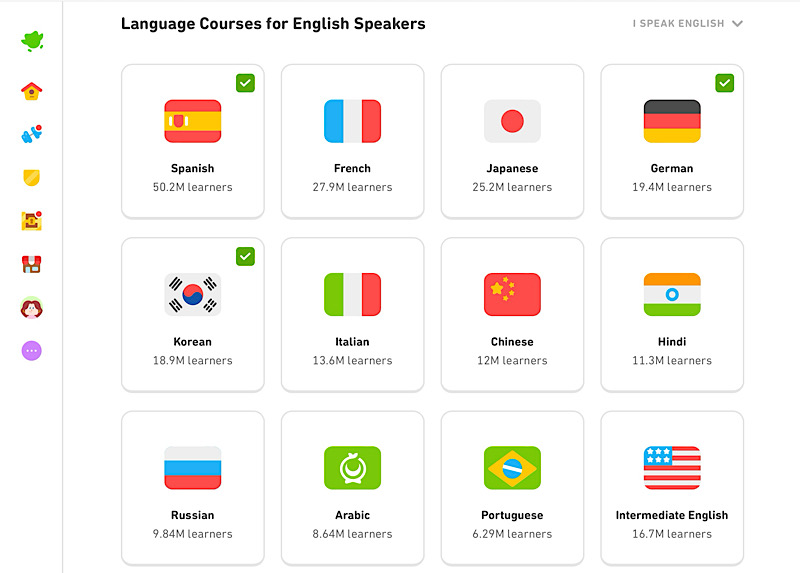
Each course consists of multiple small vocabulary units focusing on different themes, with difficulty, used vocabulary and grammar-lessons gradually increasing. Super users can also pick up on personalized lessons that focus on different learning styles, such as listening practice, speaking or vocabulary.
Special Features – and Strange Backtracks – In Our Duolingo Test
Beyond the standard language course, Duolingo offers other useful features designed to make your language progress smoother.
For ongoing motivation, there’s a leaderboard that updates regularly, letting you compare your performance against others or your own past results. You’ll also see encouragement from Duo the Mascot, which gives this software a more personal feel than many other courses.
However, this feature used to be better: in the past, you could spend Duolingo’s in-app currency on outfits for Duo, but that’s now gone. It also makes you question the point of that currency.

‒ The Best Language Course of 2025 ‒
We’ve tested dozens of language courses…
But only ONE takes the #1 spot!
Duolingo had also provided a discussion forum where users could share insights or ask native speakers for help. This was removed in late 2022 for basic users, and has now been shut down completely. It’s unfortunate—and the rationale isn’t exactly clear, as these communities offered valuable peer support.
A few other once-helpful features have disappeared too: for instance, there used to be a free dictionary where you could quickly look up vocabulary, as well as a table-style overview of words you’d learned. Both are gone. We do however really love the new daily, weekly and monthly challenges, along with the option to connect with and compete against friends.
Meanwhile, the premium plan “Duolingo Super” includes additional perks such as listening and speaking exercises. We’ll touch on that more in “Value for Money: Is Duolingo Worth It?” below.
User-Friendliness: How Easy Is Duolingo to Use?
Simple navigation and quick, intuitive controls make for a pleasant learning experience. Does Duolingo measure up in that regard?
Duolingos Interface: Absolutely Unmatched!
Duolingo’s biggest standout is its gorgeous design with so much attention to detail. Some people may find it a bit too playful or childish, but there’s no denying it’s intricate and lovingly crafted—unlike some competing software. Yes, 17minute Languages, we are talking about you.
Every lesson and in-between sequence comes with adorable illustrations, though not always super logically applied. Sometimes you’ll see random avatars delivering a sentence in a speech bubble rather than a picture of the object you’re actually learning, like an apple for “I’m eating an apple.”
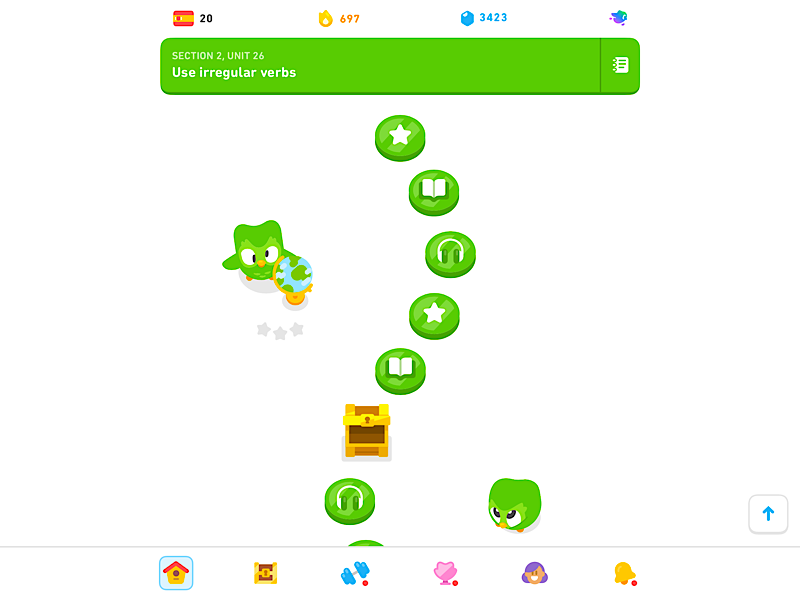
Although a lovely look can make learning more enjoyable, it doesn’t necessarily improve your actual progress. Still, Duolingo invests heavily in aesthetics—possibly at the expense of teaching quality?
Duolingo Test: App vs. Web
Duolingo is available via a web browser and on all common smartphone systems such as iOS and Android. Both mobile and browser versions share nearly identical features.
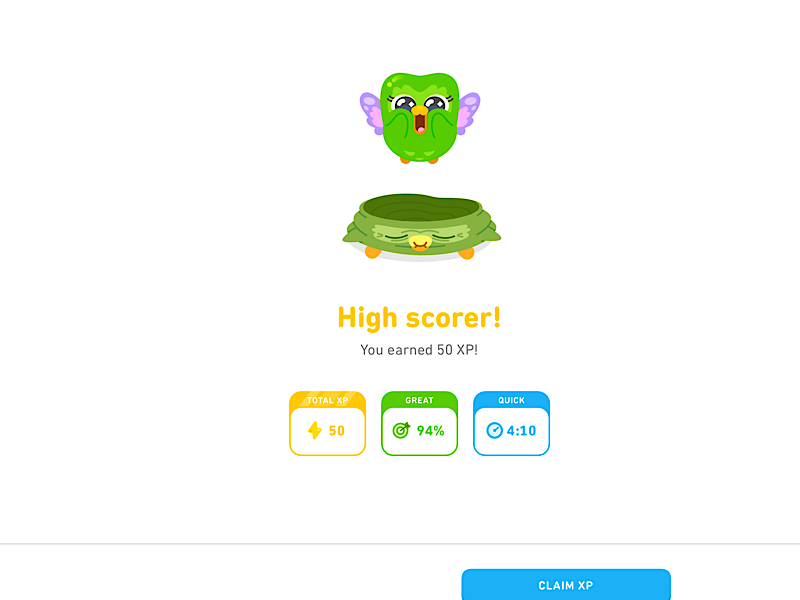
Both platforms rely on the same core courses and sync your progress, so you can seamlessly switch between mobile and browser. Since the app also requires internet, there’s not much difference in speed or data usage. Offline learning is not an option as of right now.
Summary: Duolingo’s Interface Spotlight
We test dozens of language courses, and almost none match Duolingo’s clear, well-planned setup. The interface is thoughtfully designed and easy to understand from the get-go.

‒ Black Friday: Language Special ‒
Saving money never hurt anyone, right?
Find the best discounts and exclusive coupons for top
language courses here!
+ + + Limited-Time Deals +++ Some Offers Expiring Soon +++ Don’t Miss Out! + + +
The mobile and web versions both have the same features, so either one works for daily practice. Because the app requires an internet connection anyway, there’s not a significant difference in speed or data usage.
Note that the free version includes regular ads between lessons. While they’re short, they can interrupt your study flow – another downside. Of course, the Super and Max versions do not have this issue.
Teaching Approach: How Successful Is Duolingo in 2025?
While a neat interface and attractive design are definitely perks, it’s the teaching concept that really matters. How effectively does Duolingo present its content, and what types of tasks support that learning?
Straight into the Deep End
Each lesson revolves around particular themes, all following the same pattern. It usually includes a handful of short units featuring new vocabulary (like animals, transport, plural forms, or prepositions). A unit has various tasks, such as: fill-in-the-blank, translations, pronunciation practice, and listening comprehension.
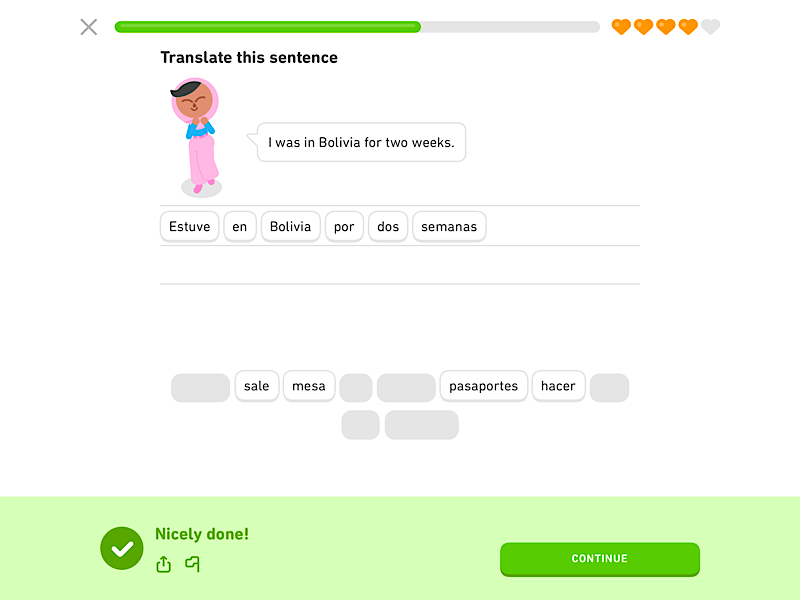
Usually, you can click each word in a sentence for a quick definition—which is essential since there’s no dedicated “study” phase before you’re tested. It’s basically sink-or-swim, learning by making mistakes or guessing. Annoying at first, but it makes sense in later lessons as it can be used to learn from context – very brain-friendly!
Various Exercises, Few Explanations
Exercises are fairly diverse and not too difficult. Sometimes they’re almost too easy and get dull—particularly with cognates like “Hotel,” which barely feels like learning. Another downside for some is the near-complete lack of grammatical explanations. Others enjoy the natural context-based learning process – it comes down to your personal preference. We would certainly enjoy the option to see a comprehensive explanation, if need be.
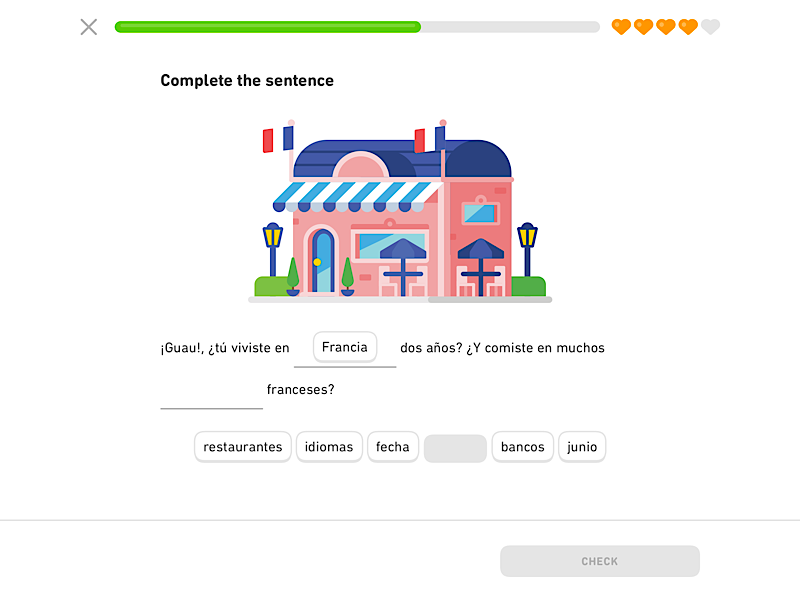
Experts still debate whether you learn better/faster by “figuring out” grammar or by direct instruction. It cnán be tricky though, especially for languages with specific grammar or a different alphabet.
Technically, it’s possible to learn a language without explicit grammar or vocab memorization—just look at our transREAL method – but Duolingo’s reliance on “best-guess translations” is inconsistent with that approach. It sometimes leaves you more puzzled than proficient.
Game, Challenge or Study Course?
Previously, each lesson gave you three “lives,” and mistakes caused you to lose one until you had to restart the entire lesson. Now it’s changed: each lesson simply requires you to finish a set number of tasks. The quantity of mistakes no longer matters for the individual lesson.
But you do still have a broader limit on “hearts” outside of the lesson itself. If you finish, say, five lessons with multiple errors, you might have to wait or watch ads to continue—unless you use the premium plan, which completely removes this limitation. Make as many mistakes as you want!
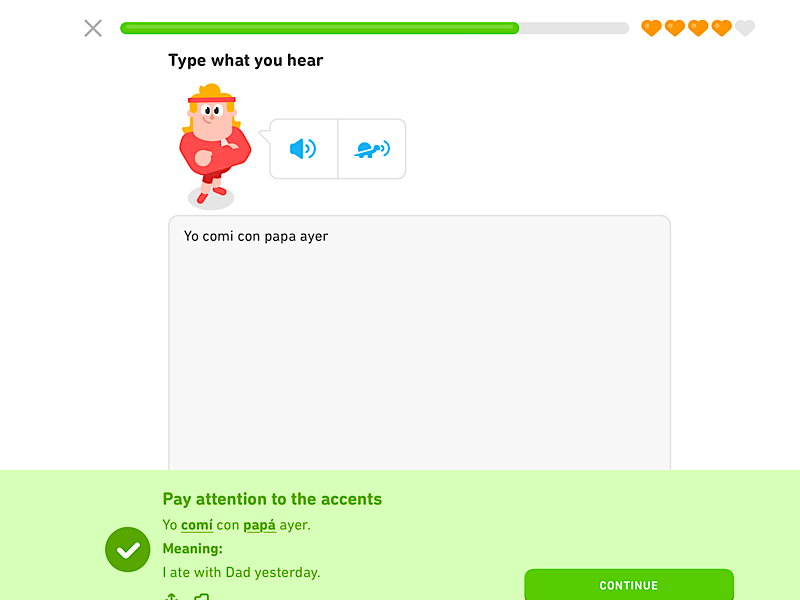
The original “challenge” vibe now mostly comes from “Gems” earned for completing lessons—these “diamonds” are meant to motivate you and can be exchanged for extra hearts (no waiting). In the past, you could use them for fun add-ons, like clothes for the mascot, but that’s gone now. You an however buy boosters for XP (used to compete in ranks) as well as advantages for the weekly challenges.
Another issue with Duolingo’s teaching approach: It depends heavily on reusing the exact same examples repeatedly. You memorize certain words in set sentences, which then get re-used in tests. In short, you’re just memorizing a single context, not truly learning flexible usage.
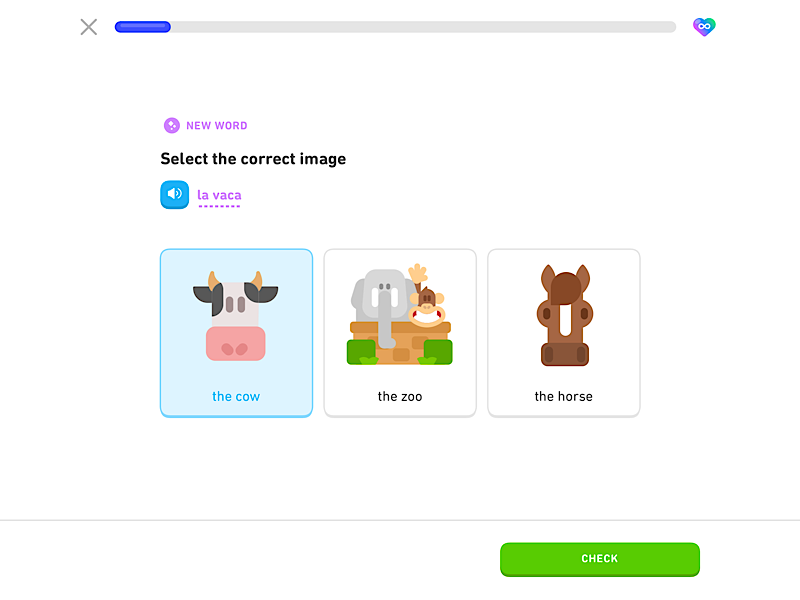
As a result, you’re just memorizing one scenario and aren’t taught how to adapt vocabulary in real-life usage. Even worse, for free users advanced lessons rarely revisit earlier vocab. The result, as I found in this Duolingo review, is that less-common words disappear from your memory, preventing a robust vocabulary base from forming. Super and Max users get practice lessons that specifically target their weak spots, which is a huge plus compared to the free version.
Provider Developments: Duolingo Max & Dropped Features
Duolingo had, albeit on a separate site, a community feature for years. Users were extremely active there, both among themselves and with the development team, reporting small bugs and suggesting improvements. Now, that’s been removed in favor of a new feature: Duolingo Max. It uses OpenAI’s technology (famous for ChatGPT) for AI-based learning.
Currently, it offers two main tools. First, “Explain my answer” gives you a short breakdown of why your answer was correct or incorrect—basically dissecting the sentence to clarify word forms and expressions. But we used to get that for free in the old forums.
Alternatively, you can have a “video call” with Duolingo character Lily, simulating a real-life conversation scenario. You train your listening and speaking skills, with Lily adjusting to your level. Feedback comes afterward, so the chat flow isn’t broken. This is Duolingo’s step into AI tutoring—a major trend in modern online language learning.
Right now, Duolingo Max is available for Spanish, and French, with more options and languages already in development. But it’s pricey: while Duolingo Super is around €6.49 monthly (and even under €2 per person in a family subscription), Duolingo Max comes in at about €14 per month on an annual plan- over two times the cost.
We appreciate seeing them keep up with recent times, but Duolingo Max is too expensive for what’s on offer, especially with competing AI solutions that are cheaper and further along in development. We’re curious to see Duolingo’s next moves though!
Summary: Duolingo’s Teaching Approach Under Evaluation
Although Duolingo does well in other areas, its teaching approach simply isn’t strong enough yet. Sure, it’s a fun starter for total beginners, but “the best way to learn a language” (Duolingo’s own claim) it is not. However: Recently they have picked up speed with regular updates, more gamification, new kinds of exercises and AI-implementation leave us hopeful for the future. Keep it up, Duolingo!
Target Audience: Who Is Duolingo For?
We’ve looked at Duolingo’s features in detail – who is their target audience and who do we recommend it to?
Beginner-Friendly—but Not Much More
We recommend Duolingo mostly for newcomers. Beyond that, the content can be a little too basic. The software tries to train all language skills—reading, listening, writing, speaking. That offers a good start and basic understanding of the desired target language.

‒ The Best Language Course of 2025 ‒
We’ve tested dozens of language courses…
But only ONE takes the #1 spot!
That makes Duolingo better for a visual or auditory learner, not so much social or communicative learners. Busuu for example is stronger in those areas.
Value for Money: Is Duolingo Worth It in 2025?
The paid premium plan, Duolingo Super, promises up to four times faster progress than the free version. But what does Super actually offer, how much does it cost, and is it worth the price? Let’s break down the Duolingo costs…
Extra Features with Duolingo Super
Paying for the upgrade brings four key benefits:
- A personalized training system that revisits commonly missed words
- Exercises for speaking and listening comprehension
- Unlimited “hearts” (learn as much as you want without pausing)
- No ads between lessons
Overview of Purchase Options
Duolingo lets you try the premium plan for 14 days at no charge, but if you don’t cancel in time, you’ll roll into a paid subscription. You can choose from three main plans: two for individuals plus a new family plan for 2–6 users.
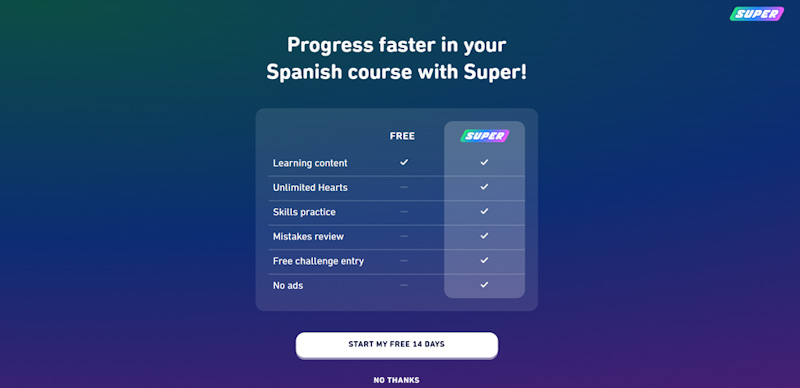
1-month plan: $12.99 monthly (single user)
12-month plan: $6.99 monthly (single user)
12-month plan: $119.99 total, so $9.99 monthly (family, 2–6 users)
Duolingo Max starts at around $19.99 monthly for a family plan, again up to 6 users. Prices for one should be around $14.99 for a yearly subscription and $30 for a monthly one – however its really hard for us to confirm, as checking Duolingos prices is insanely annoying. There is no way to check for pricing without signing in or creating an account and going through screens over screens over screens. How about easy access to your pricing, Duolingo? On top of that, if you already have a subscription (like we do) and they change their costs, there is virtually no way to check without creating another account or cancelling the subscription. So annoying and not at all user-friendly!
Is the Price Justified?
To answer this, it helps to see what else is out there. So you don’t have to scour the internet for each language course, we’ve created a handy overview: the top and most popular courses at a glance. We’ll also share tips on how to get the most for your money.
Speaking of saving: Learning a new language doesn’t have to be expensive. Check out the latest coupons and discounts so you can start your language adventure on a budget. It’s worth a look, especially since there are other innovative providers out there. Don’t miss out!
So – Is Paid Duolingo Worth It?
Depending on your study workflow, it can be useful, especially since you are avoiding all those advertisements between each lesson. The personalized quizzes are a great motivator, and the additional listening and speaking exercises make good premium perks. However, Duolingo Max seems overpriced for what it offers, especially compared to other, way more developed AI courses.
The monthly plan also feels quite expensive for the level you get. The annual plan is more worthwhile for dedicated learners, and the family plan is a solid deal – up to six people for under €2 a month each!
So our recommendation: Use the free trial first to see whether a Duolingo subscription makes sense for you. Just remember to cancel in time if needed; otherwise it might be a pricey mistake. Keep in mind, though, that the premium plan doesn’t fix all the teaching flaws—so you might consider trying stronger alternatives anyway…
Alternatives: Are There Better Options Than Duolingo?
Duolingo used to be considered the top online language solution. Now, you might wonder if it’s been overtaken by newer, better courses. Here are two Duolingo alternatives that we think outperform it.

‒ Black Friday: Language Special ‒
Saving money never hurt anyone, right?
Find the best discounts and exclusive coupons for top
language courses here!
+ + + Limited-Time Deals +++ Some Offers Expiring Soon +++ Don’t Miss Out! + + +
Rocket Languages – A Strong Teaching Approach Using the Birkenbihl Method
Rocket Languages is pretty much the first app to truly embrace the Birkenbihl Method for language learning. We’ve always liked the technique, and the app cleverly adapts it for mobile use. We were seriously impressed during our Rocket Languages test.
With a money-back guarantee and a fair trial option, Rocket Languages is a top recommendation—if you like a different learning concept. The one-time purchase unlocks all languages and courses for life, with no ads to break your focus.
Mondly – The Motivator
Mondly has skyrocketed to fame among language apps, racking up award after award. It took our top spot for “motivation,” because I still enjoy using Mondly—even though we had stopped using Duolingo, Drops, and others!
Throw in Mondly’s terrific price-performance ratio, and you have a standout alternative to Duolingo—especially if you grab the lifetime deal unlocking all languages forever. Plus, you’ll get free access to Mondly Kids, so your entire family can enjoy studying.
talkREAL Tip: Check out our expanded Duolingo Guide for more direct comparisons between Duolingo and other courses.
Conclusion: Duolingo Falls Short in Our 2025 Test
– Suitable for beginners, but there are better teaching approaches elsewhere –
“Duolingo isn’t really a language-learning program anymore; it’s a game program that happens to include foreign languages,” commented our reader Horst Bekmann. We couldn’t have put it better.
Yes, Duolingo can be fun for a quick, casual session, and beginners willcertainly learn the basics. But a cute owl and endless gamification elements don’t make a high-quality language course—especially when the content is stil lacking in some parts. Though it also has its advantages – depending on what you are looking for in an app or online course.
Purely in teaching terms, better options exist. Our real-world observations confirm that. In all the time we’ve supported learners at talkREAL, we’ve never met anyone who truly mastered a language with Duolingo alone. On the other hand, we’ve seen success stories with Mondly, Gymglish, and Mosalingua, for instance.
Yes, we’ve been criticized before for our negative Duolingo test. Maybe other reviewers should spend a few weeks, as we do, fully immersed in the app, and they might see why we’re unimpressed. We’ll keep posting honest reviews, whether it’s a small startup or a billion-dollar company.
Teaching Approach:
6.0 / 10
Usability:
9.0 / 10
Value for Money:
7.0 / 10
Overall Rating: 7.3 / 10
“`
